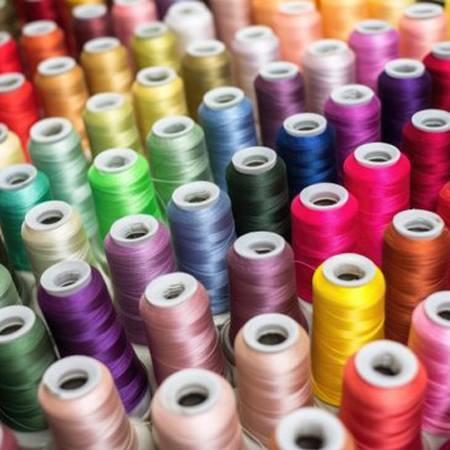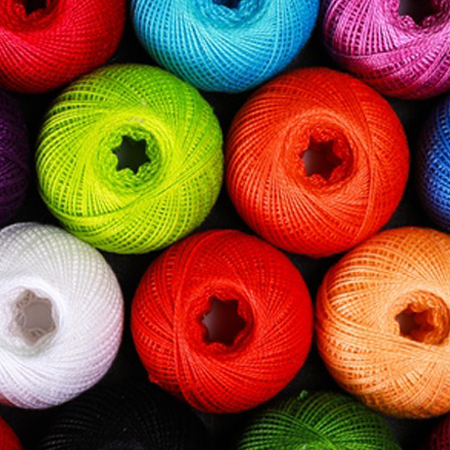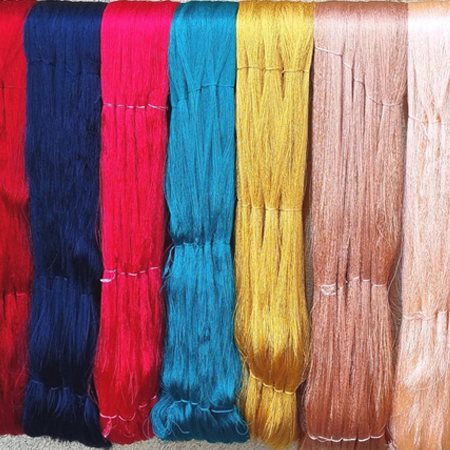
Yarn / Fibre
Yarn is a continuous strand of fibers that can be spun into textile or sewing thread, used for knitting, weaving, crocheting, and other forms of textile production.Fiber refers to the raw material used to produce yarn and fabric. Fibers can be natural or synthetic and are categorized based on their origin and composition.
- Soft, breathable, and versatile; widely used in clothing and household textiles.
- From sheep, known for its warmth, elasticity, and moisture-wicking properties.
- Produced by silkworms, valued for its smooth texture, sheen, and luxurious feel.
- Made from flax fibers, known for its strength, durability, and coolness.
- Yarn and fibers are essential for making garments, upholstery, bedding, and other textile products.
- Used in knitting, crocheting, weaving, and embroidery projects to create clothing, accessories, and decorative items.
- Certain fibers and yarns are used in specialized industrial applications such as automotive textiles, filtration, and aerospace materials.
Knitted Fabric & Woven Fabric / Garments
Knitted fabric is created by interlocking loops of yarn, either by hand or with knitting machines. The loops can be formed in various ways, resulting in different textures and stretch properties.Woven fabric is produced by interlacing two sets of yarns at right angles to each other, forming a stable structure. This is typically done on a loom, where one set of yarns (warp) runs lengthwise, and the other set (weft or filling) runs crosswise.Garments are made by cutting and sewing fabric pieces together, following patterns and designs. Both knitted and woven fabrics can be used to make garments, each offering unique characteristics and aesthetic qualities.
- Knitted fabrics are generally more elastic and stretchy compared to woven fabrics, due to the interlocking loop structure.
- They are often soft and comfortable to wear, conforming to the body’s contours.
- Woven fabrics are generally stronger and more durable than knitted fabrics due to the crisscrossing yarns.
- They have less stretch and are more stable in shape compared to knitted fabrics
- Garments made from knitted fabrics tend to have a snugger fit due to their stretch, while woven fabric garments may have a more structured fit.
- Knitted garments often provide better ease of movement and comfort for casual and active wear, while woven garments may be tailored for a more formal look
- Workwear, uniforms, and specialized garments for specific industries (e.g., healthcare, hospitality).


Cotton
Cotton is a soft, fluffy fiber that grows in a boll around the seeds of the cotton plant (Gossypium). It is harvested and processed into various forms for use in textiles, clothing, and numerous industrial and consumer goods. Understanding the different types of cotton and their properties helps in selecting the right fabric for specific needs while considering environmental and sustainability factors.
- Cotton fibers are naturally soft and comfortable against the skin, making cotton fabrics pleasant to wear in both hot and cold weather.
- Cotton is highly breathable, allowing air to circulate through the fabric. This property makes cotton garments cool and comfortable, ideal for summer clothing and activewear.
- Known for its long fibers (staple fibers), which produce exceptionally soft and luxurious fabrics. Egyptian cotton is often used in high-quality bed linens and clothing.
- Similar to Egyptian cotton, Pima cotton has long fibers and is known for its durability and softness. It is primarily grown in the United States.
- Cotton is used to make a wide range of clothing items, including T-shirts, shirts, jeans, dresses, underwear, and socks.
- It is used in bedding (sheets, pillowcases), towels, curtains, upholstery fabrics, and table linens.
- Cotton fibers are biodegradable and recyclable, contributing to efforts in sustainable fashion and circular economy practices.
Polyester / Nylon / Modal
Polyester, Nylon, and Modal are synthetic fibers widely used in the textile industry due to their specific properties and versatility.Polyester is a synthetic fiber made from petrochemicals, primarily derived from petroleum and natural gas.Nylon is a synthetic polymer fiber known for its strength, elasticity, and abrasion resistance.Modal is a type of regenerated cellulosic fiber, derived from beech tree pulp.
- Polyester fibers are strong and resistant to stretching and shrinking, making them durable and long-lasting.
- Polyester fabrics are generally resistant to wrinkles and creases, requiring minimal ironing.
- Nylon has good elasticity, allowing it to stretch without losing its shape, which is ideal for sportswear and activewear.
- Nylon fibers are exceptionally strong, making them durable and resistant to wear and tear.
- Modal fibers are known for their silky soft texture and luxurious feel, often compared to natural fibers like silk.
- Modal fabrics have excellent color retention, retaining their vibrancy even after multiple washes.
- Valued for its softness, breathability, and luxurious feel, often used in apparel and home textiles. .


Silk & Wool
Silk and wool are both natural fibers used extensively in textiles, but they have distinct properties and uses.Silk is a natural protein fiber produced by the larvae of the silk moth, primarily the Bombyx mori.Wool is a natural protein fiber obtained from sheep and other animals, including goats (cashmere and mohair), rabbits (angora), and alpacas.silk and wool offer unique benefits, making them highly valued in different applications depending on the desired qualities such as texture, appearance, and thermal properties.
- Has a natural sheen due to its triangular prism-like structure, which refracts light at various angles.
- Effective thermal regulator, keeping cool in summer and warm in winter.
- Often requires hand washing or dry cleaning to maintain its quality. Should be stored away from direct sunlight to prevent fading and deterioration.
- Can absorb a significant amount of moisture without feeling damp, helping regulate body temperature.
- Generally requires gentle washing or dry cleaning to avoid shrinkage and felting. Should be dried flat to maintain its shape and prevent stretching.
- Superior for cold weather insulation, retaining warmth even when damp.
- Perfect for warm clothing, home textiles, and industrial uses.
Viscose / Rayon
Viscose, commonly known as rayon, is a semi-synthetic fiber made from cellulose, typically derived from wood pulp, cotton linters, or other plant materials.Smooth, soft, and comfortable, often compared to silk in its feel.Can be shiny or matte, depending on the manufacturing process.Ironing may be needed to remove wrinkles, typically done on a low to medium heat setting.
- Allows air to pass through, making it comfortable to wear in warm weather.
- Excellent draping qualities, making it suitable for garments that require a good flow.
- Should be dried flat or on a hanger to maintain shape and prevent stretching. Ironing may be needed to remove wrinkles, typically done on a low to medium heat setting.
- The production process involves chemicals that can be harmful to the environment if not managed properly.
- Both are smooth and soft, but silk has a natural sheen that viscose can mimic but not perfectly replicate. Silk requires more delicate care compared to viscose.
- Both can be derived from plant cellulose, but cotton is naturally occurring while viscose is chemically processed.
- Viscose is softer and more breathable, while polyester is more durable and less prone to wrinkling.

